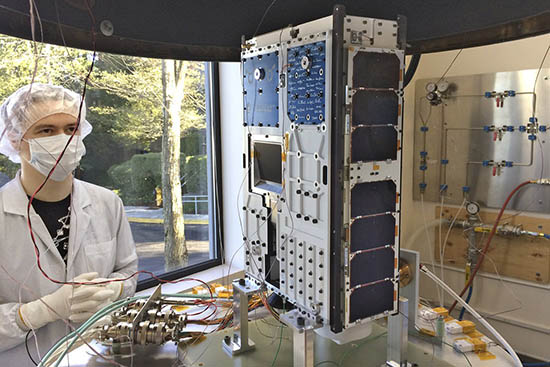太空采矿业有望成为现实
|
在小行星上采矿或取水都不是什么天方夜谭。在三年前的一次访谈中,天体物理学家尼尔·德格拉塞·泰森就说过,地球上的第一位亿万富翁将是“那个在小行星上开采自然资源的人”。 很多创业者都在进行尝试。最引人注目的是成立于2012年的太空采矿初创公司Planetary Resources,它的投资人包括电影导演詹姆斯·卡梅隆以及谷歌的联合创始人拉里·佩奇。 2018年年初,Planetary Resources一飞冲天。当时它刚刚发射了一颗自行设计的全新微型卫星,这颗卫星可以通过中波红外热成像仪发现地球大气以外的水资源。这是该公司的第一步,它的长期目标则是最终拿下首个小行星采矿权。 |
Mining asteroids for either the minerals they contain or the water they hold isn’t some outlandish fantasy. In an interview three years ago, astrophysicist Neil deGrasse Tyson said that Earth’s first trillionaire would be “the person who exploits the natural resources on asteroids.” A number of entrepreneurs are taking their shot. The splashiest space-mining startup, Planetary Resources, was founded in 2012 and boasts investors including movie director James Cameron and Google cofounder Larry Page. At the start of 2018, Planetary Resources was literally flying high. It had just launched a brand-new miniature satellite of its own design, one that would use a mid-wave infrared imager to sniff out sources of water beyond Earth’s atmosphere. It was the first step toward its longer-term mission to eventually stake the first asteroid-mining claim. |

|
两年前,Planetary Resources融资2100万美元,随后又通过与卢森堡政府签署合作伙伴协议获得2800万美元资金——卢森堡想成为行星际采矿所有相关事务的地面枢纽。 但这家设在华盛顿州雷德蒙德的商业太空创业公司很快就发现自己陷入了困境——融资不足导致裁员。据说其员工人数从大约70人减少到了10人左右,而且还向卢森堡政府转让了10%股权。到了8月底,该公司的首席执行官克里斯·莱维茨基已经在打算拍卖笔记本电脑等设备了。莱维茨基拒绝就本文接受采访。 虽然小行星采矿可能是个很赚钱的行当——高盛集团的一篇报告估算,一颗小行星上就可发现价值高达500亿美元的铂金,但此项业务面临的技术问题尚未得到解决。外部观察人士指出,所有打算上太空采矿的公司最好都要为长期等待做好准备。 科罗拉多矿业学院的一位太空资源课程教授乔治·索尔斯说:“开创这个全新领域会遇到很多障碍,所以任何对此抱有雄心壮志的初创公司都必须踏踏实实地找到收入来源。” Planetary Resources的竞争对手、设在圣何塞的Deep Space Industries公司(简称DSI)已经不再把小行星采矿作为业务重点,因为它首先要充分确信登陆小行星的成本不会让自己破产。 18个月来,DSI反而一直在开发成本不超过1000万美元的航天器。CEO比尔·米勒说:“我们非常需要低成本深空运输。一种具有商业可行性的策略,这是目前我们的专注点。” 随后,在今年10月,小行星采矿行业和另一项力争塑造我们这个世纪的技术发生了碰撞——设在布鲁克林的区块链公司ConsenSys收购了Planetary Resources的资产。ConsenSys的创始人乔·鲁宾还与他人一同创立了加密货币以太坊。 没人能说清楚一家区块链初创企业究竟想从一家太空采矿公司那里得到什么。本次收购的细节属于保密信息,而鲁宾的声明好像是在说向太空进军是ConsenSys自然发展的结果。他表示,收购Planetary Resources“体现出我们对航天事业民主化和去中心化的信心”。然而,对于通过太空采矿牟利的宏伟事业,本次收购透露出的信息却很简单,那就是另辟财路,至少目前要这样做。 亚利桑那大学教授、美国国家航空航天局(NASA)的OSIRIS-REX小行星项目首席研究员但丁·洛雷塔去年曾表示,在10年内开展太空采矿的想法似乎可行。今年他又说,太空采矿给人的感觉崇高了很多。 洛雷塔指出:“登陆小行星、处理开采物,然后运回来要花很长时间。这是一种跨度达到几十年的展望。” 洛雷塔是Planetary Resources的科学顾问委员会成员,他们上次开会的时间是在2017年12月。 但这并不是说今后在小行星上开采资源遥不可及。NASA的OSIRIS-REX探测器正在接近小行星贝努,它会在2020年夏天尝试在贝努上着陆,然后采集样本并返回地球。 洛雷塔说:“我仍然相信小行星采矿的科学和工程难题都能彻底解决。没有什么是我们解决不了的。那只不过是个制定业务方案的问题。”(财富中文网) 本文另一版本刊登在2018年12月1日出版的《财富》杂志上,题为《太空采矿回到现实》。 译者:Charlie 审校:夏林 |
Two years earlier, the company had raised $21 million, and then another $28 million through a partnership deal with the government of Luxembourg—a country trying to position itself as the Earth-based hub for all things interplanetary mining–related. But the commercial space venture based in Redmond, Wash., soon found itself in trouble: A fundraising shortfall led to employee cutbacks—reportedly shrinking a staff of about 70 workers to roughly 10—and to Luxembourg selling its 10% stake in the company. By the end of August, CEO Chris Lewicki, who declined an interview for this story, was planning to auction off laptops and other equipment. While asteroid mining is a potentially lucrative business—a Goldman Sachs report estimated the platinum found on one asteroid to be worth as much as $50 billion—the technical challenges of mining them are still being figured out. Outside observers say that any company interested in drilling space rock had best be prepared for a long wait. “There are going to be a lot of bumps in the road to create this entirely new field, so any startup company that had these grand ambitions has to be pragmatic about establishing a revenue stream,” says George Sowers, a professor in the space resources program at the Colorado School of Mines. A Planetary Resources competitor, Deep Space Industries (DSI), in San Jose, has abandoned its focus on mining asteroids until it can be reliably certain that the cost of traveling to them won’t bankrupt the business. For the past 18 months, DSI has instead been developing spacecraft that will cost less than $10 million. “There’s a big need for low-cost transportation to deep space,” says its CEO, Bill Miller. “A commercially viable strategy; that’s what we’re focused on today.” Then, in October, the asteroid-mining industry collided with another technology vying to define the rest of the century. Planetary Resources’ assets were acquired by ConsenSys, a Brooklyn-based blockchain company founded by Joe Lubin, cofounder of the cryptocurrency Ethereum. Just what, exactly, a blockchain startup wants with a space-¬mining company is anyone’s guess. Details about the transaction are confidential, and in a statement, Lubin made it sound as if adventuring into space is a natural outgrowth for his company, noting that the purchase “reflects our belief in democratizing and decentralizing space endeavors.” For the broad endeavor of fracking the galaxy for profit, however, the underlying message is a simple one: Find an alternative source of funding, at least for the time being. According to University of Arizona professor Dante Lauretta, a principal investigator for NASA’s Osiris-Rex asteroid mission, the idea of space mining within the next decade seemed like a viable goal—last year. This year, he says, it feels much more lofty. “It takes a long time to get up to an asteroid, to process material, to deliver that material. It’s a multi-decade kind of prospect,” says Lauretta, who serves on Planetary Resources’ scientific advisory board (which last met in December 2017). But that doesn’t mean a future in which asteroids are mined for resources is out of reach. The Osiris spacecraft is approaching an asteroid named Bennu and will attempt to land on its surface in the summer of 2020 to collect a sample to return to Earth. “I’m still of the opinion that the scientific and engineering challenges of asteroid mining are completely surmountable. There’s nothing we can’t solve,” Lauretta says. “It’s just a matter of getting the business case in place.” A version of this article appears in the December 1, 2018 issue of Fortune with the headline “Space Mining Comes Down To Earth.” |













